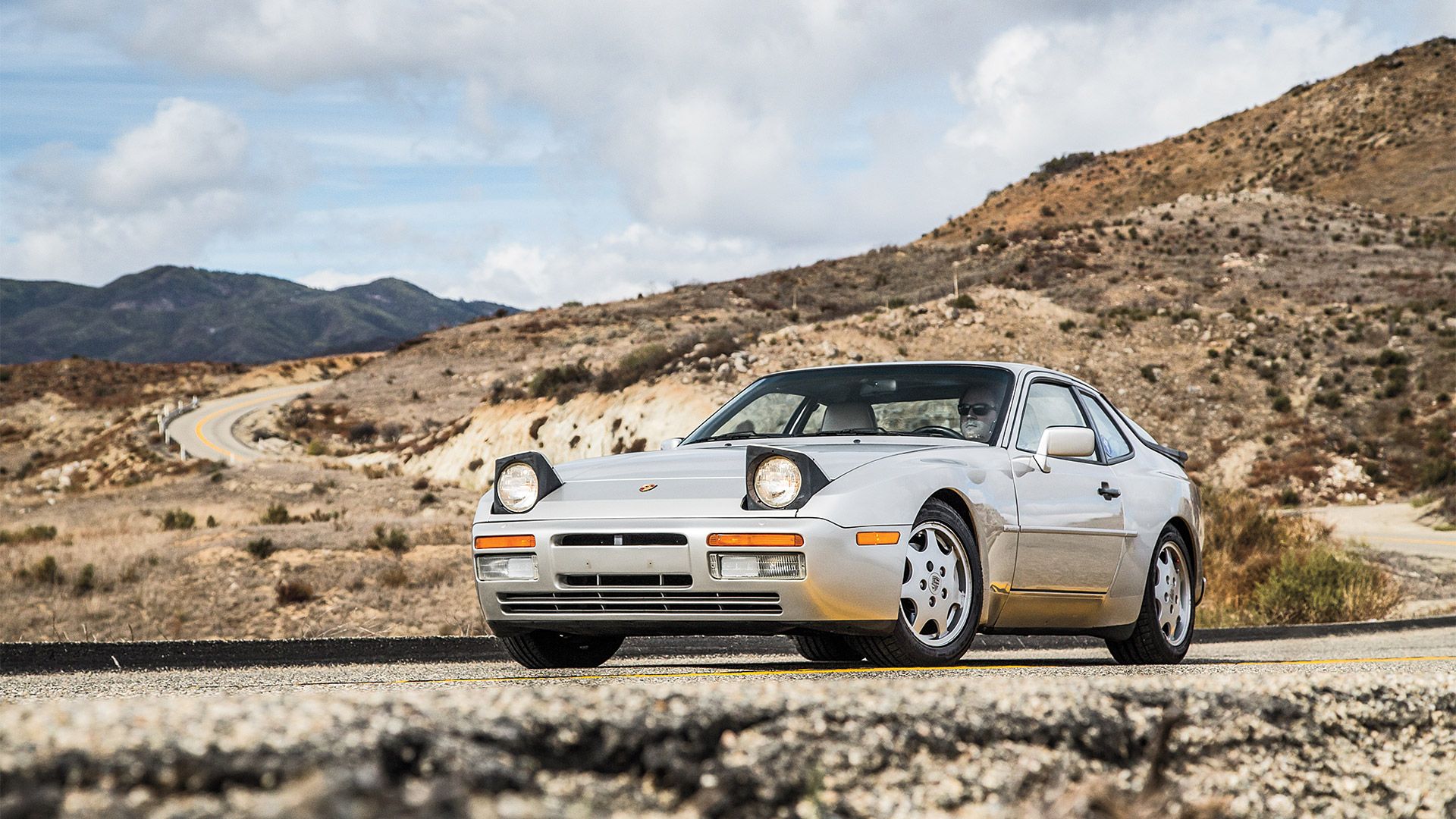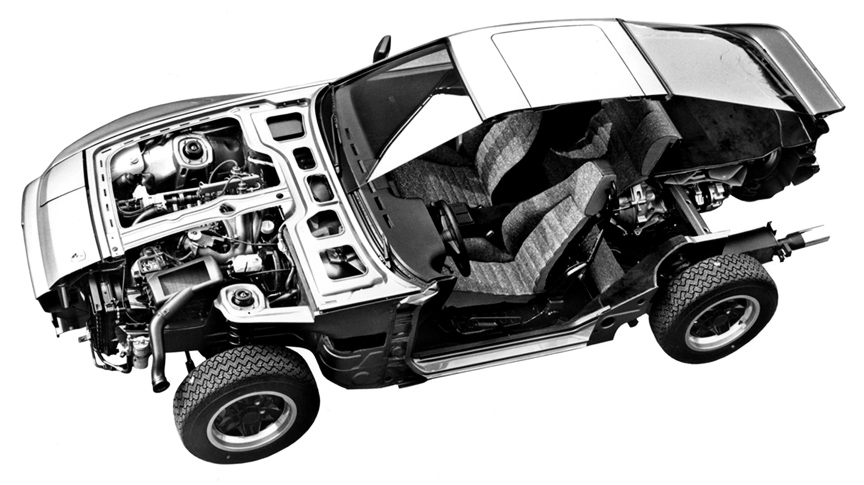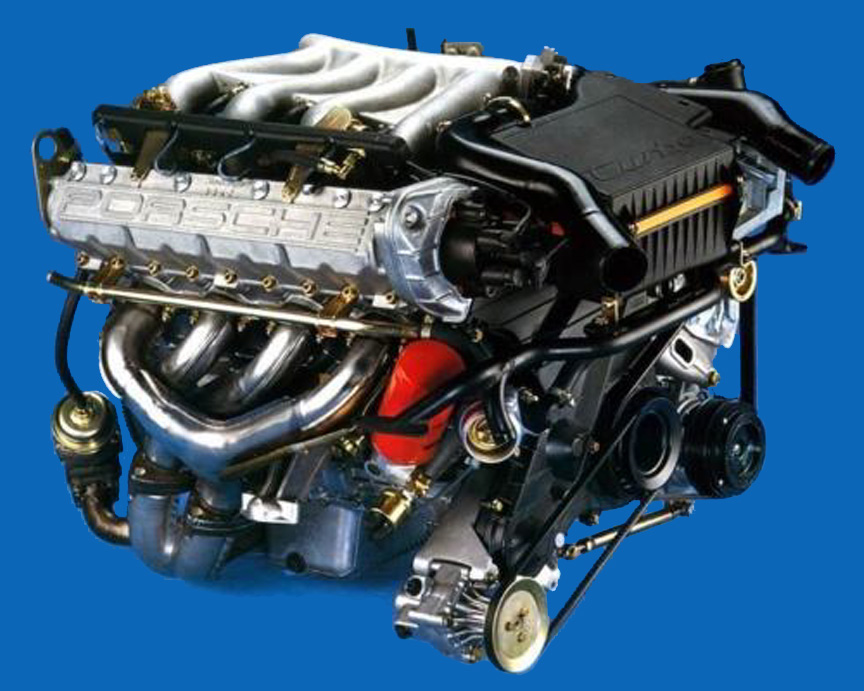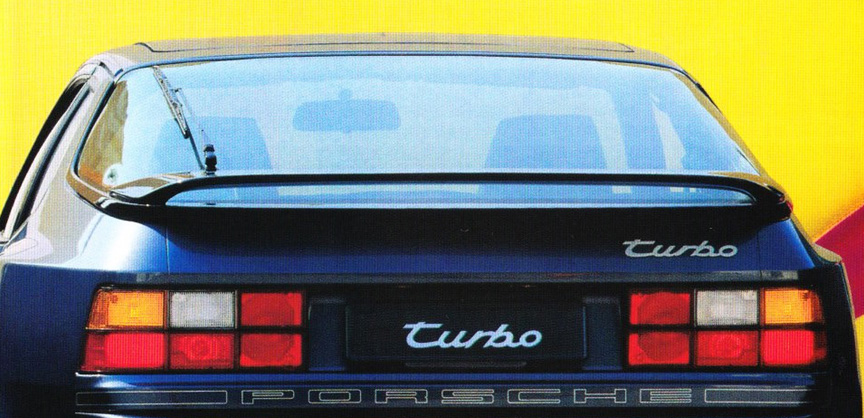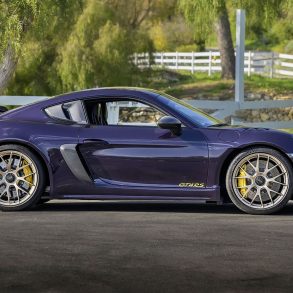Porsche 944 History & Story
The predecessor, the 924, was initially designed for Volkswagen. It was beautifully done by Porsche and the technical concept of front engine and rear transmission was top notch, but it didn’t have the Porsche engine. The natural evolution of the 924 would be to equip it with a real Porsche engine. The base for the 944 engine design came from the aluminium V8 of the 928. One bank of it was used, so to speak, and with longer stroke a 2.5-litre inline-4 was created. So, the history of the 944 starts with an engine. But not with the series production engine! The history of the 944 starts with a racing engine.
Although the exterior design of the 944 was finalized by the beginning of 1981, the presentation was postponed to September 1981 for the IAA (Internationale Automobil-Ausstellung) Frankfurt Motor Show. This meant the first thing ‘944’ to arrive publically, was the 2.5-litre 16-valve turbo engine called ‘944 Le Mans’ that was installed in one of the 924 GTR racing cars for the Le Mans 24 hour race in June 1981. The text on the engine read ‘944 Le Mans’ (it was the name of the engine, not of the car). Walter Röhrl and Jürgen Barth finished with excellent 7th place overall. The 944 LM engine was the first Porsche engine to use fully electronic fuel injection system in racing.
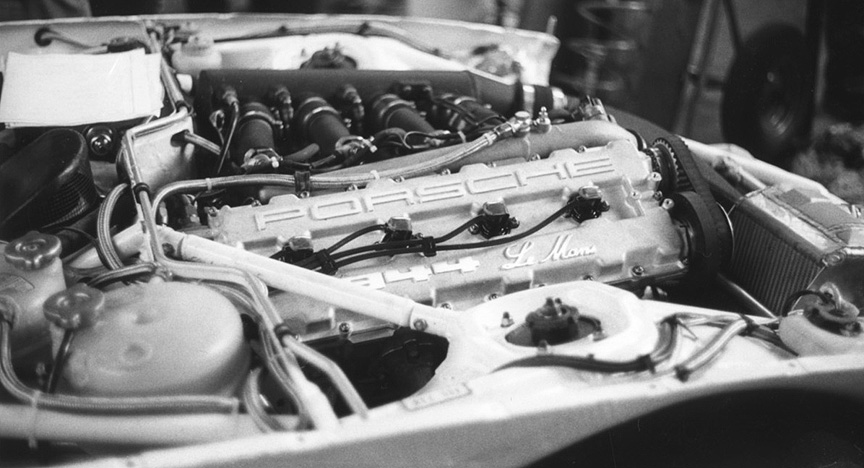
Although the exterior design of the 944 was finalized by the beginning of 1981, the presentation was postponed to September 1981 for the IAA (Internationale Automobil-Ausstellung) Frankfurt Motor Show. This meant the first thing ‘944’ to arrive publically, was the 2.5-litre 16-valve turbo engine called ‘944 Le Mans’ that was installed in one of the 924 GTR racing cars for the Le Mans 24 hour race in June 1981. The text on the engine read ‘944 Le Mans’ (it was the name of the engine, not of the car). Walter Röhrl and Jürgen Barth finished with excellent 7th place overall. The 944 LM engine was the first Porsche engine to use fully electronic fuel injection system in racing.
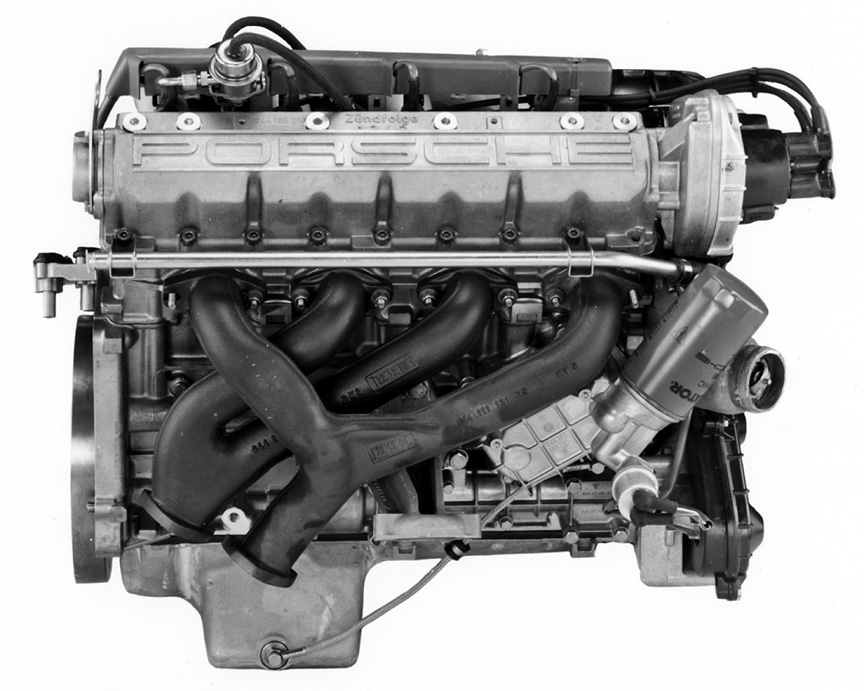
Although the ‘944 Le Mans’ engine was a powerhouse, experimental highly tuned engines are never installed in series production cars. For the first years of production, turbocharging would not be offered at all for 944. The normally aspirated series production engine developed 120 kW without catalytic converter (which was not compulsory in Europe).
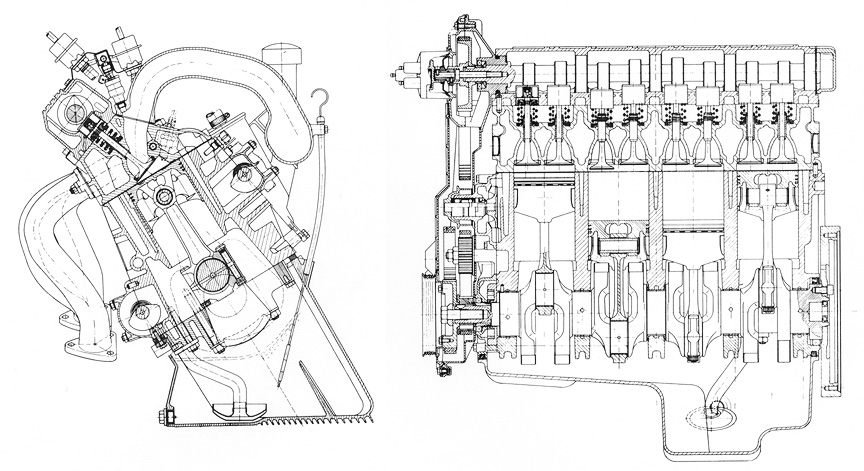
With its 2.5-litres of displacement the engine was quite big for a 4-cylinder and in order to make it run smoothly, balancing shafts were used with a patent from Mitsubishi. The 944 engine happily started from the first turn and ran really smoothly – it was so sophisticated compared to the 924. It was a strong step forward in terms of power compared to the normally aspirated 924, but not compared to the turbocharged 924 engines (not to speak of the 924 Carreras which were really powerful).
Both the 924 and the 944 were designed under head designer Anatole Lapine. Most of the credits with the original narrow body 924 went to Harm Lagaay who worked for Porsche until 1977 (Lapine left by the end of 1988 and then Lagaay returned as his successor). The 944 got its exterior design mostly from the 1979 widebody 924 Carrera GT prototype, just that new rear fenders were designed. Not all the design features from the 924 GT prototype made to the series production 924 Carreras, but they all made to the 944. The production 924 Carrera versions were even better looking than their prototype was, but the design that the 944 got from the 924 Carrera prototype, is definitely a very good one. Compared to the 924 Carrera, the 944 got real widened rear fenders (924 Carreras had rear wheel arch extensions over the narrow body of the 924). So, the rear end of the 944 was better than of the 924 Carrera, but the front was more agressive on the 924 Carrera. What you pay is what you get – the 944 was much more affordable than the 924 Carrera.
In 1981, 4-wheel drive system for 911 was experimented and in 1982 it found its way to one experimental 944. It was a 944 with rear engine and four wheel drive.
This 4WD system, designed for 911, didn’t go into production, though. The engine in the car came from a project where Porsche had designed a “flat inline-4” engine for Volkswagen to use under floor – that didn’t go into production, either.
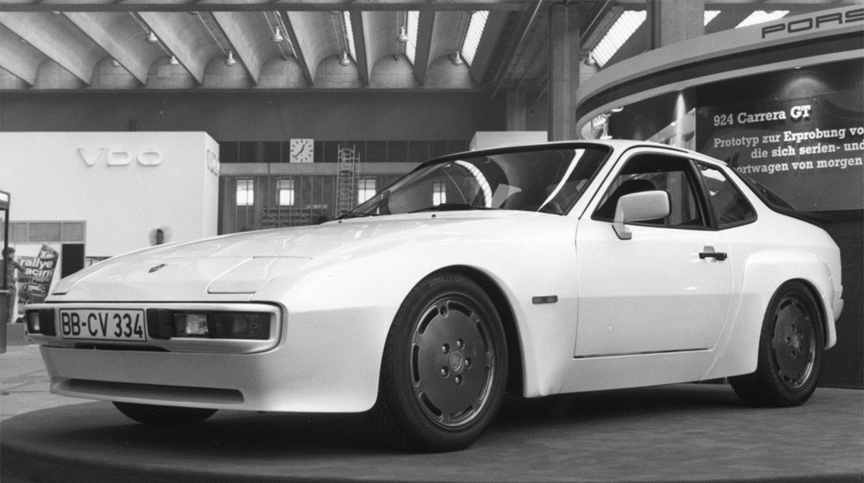
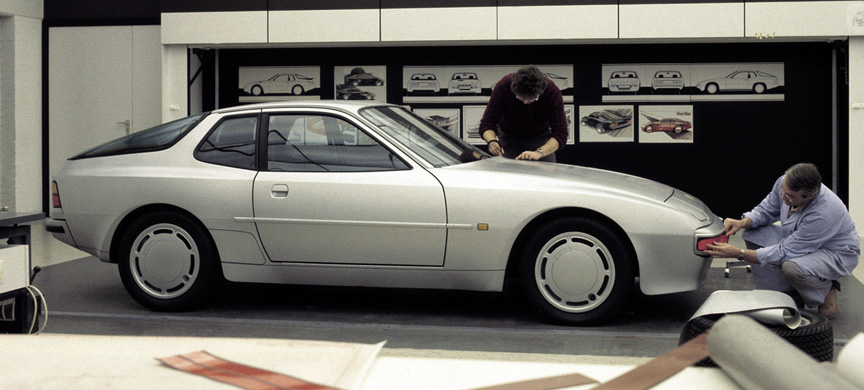
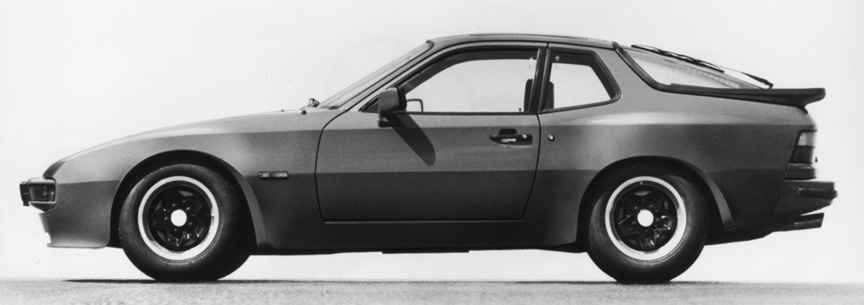
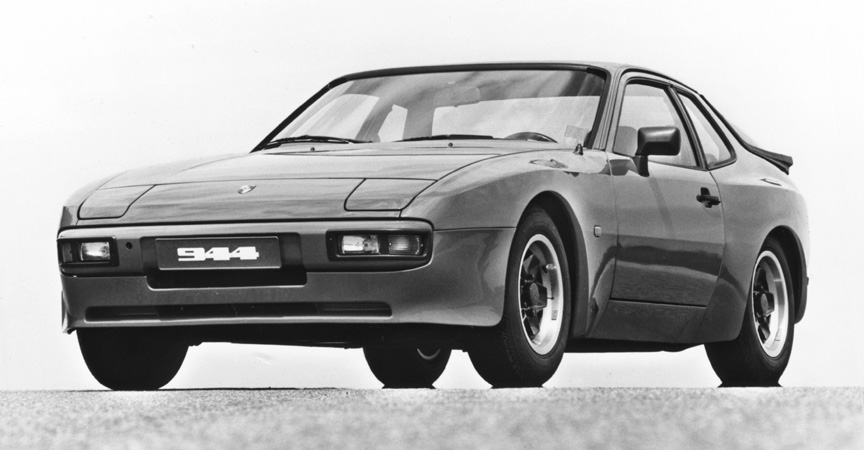
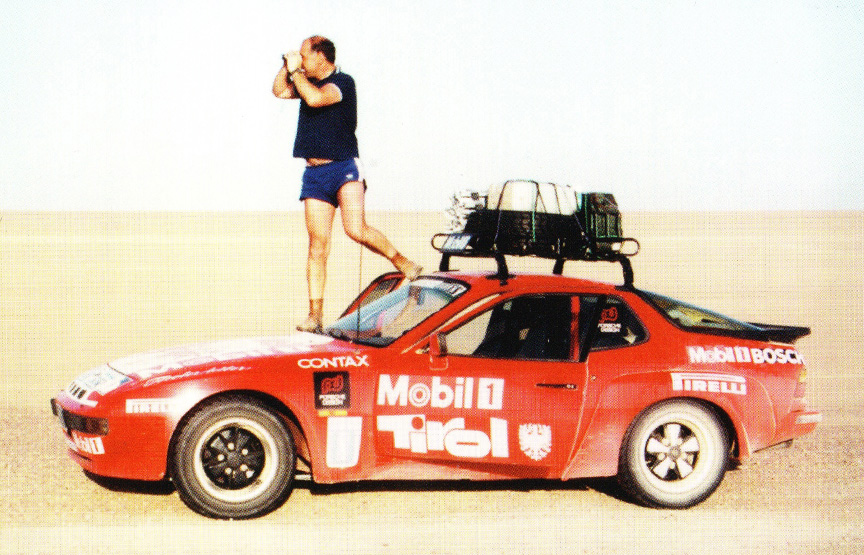
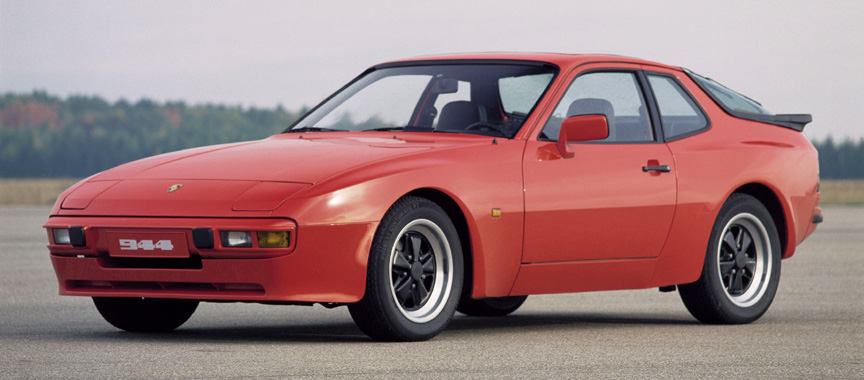
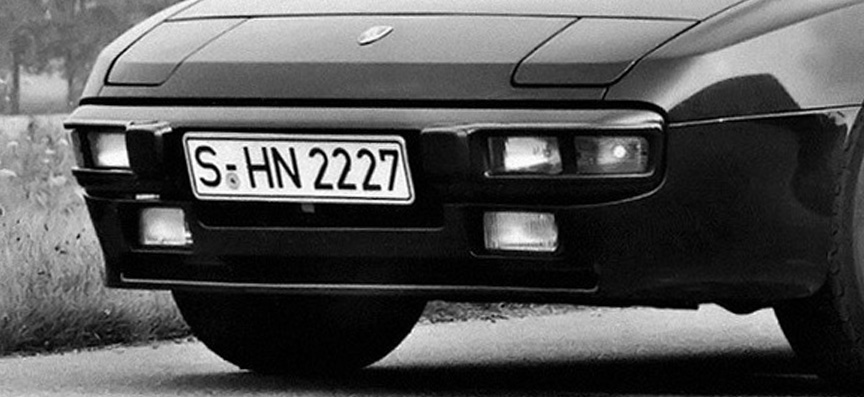
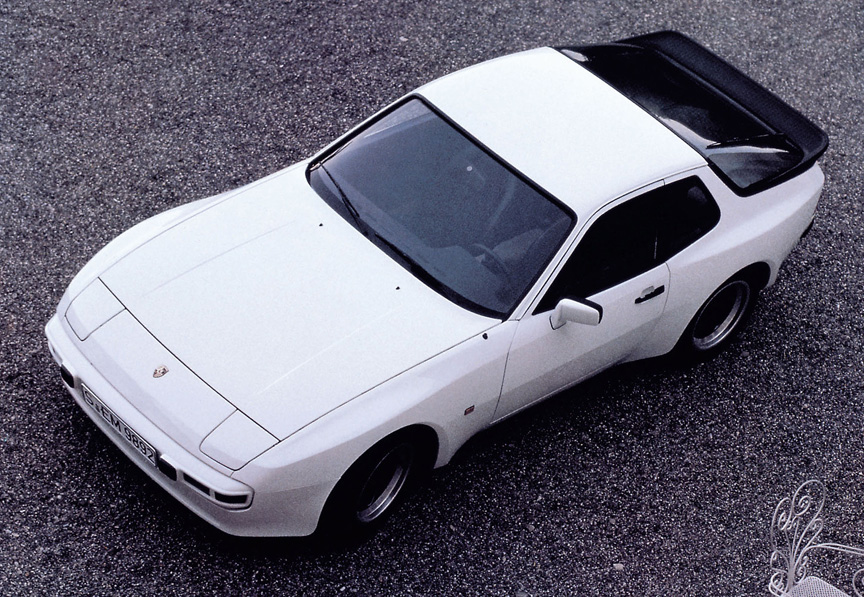
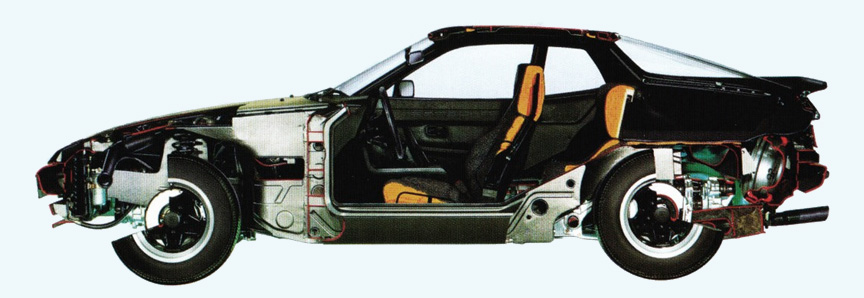
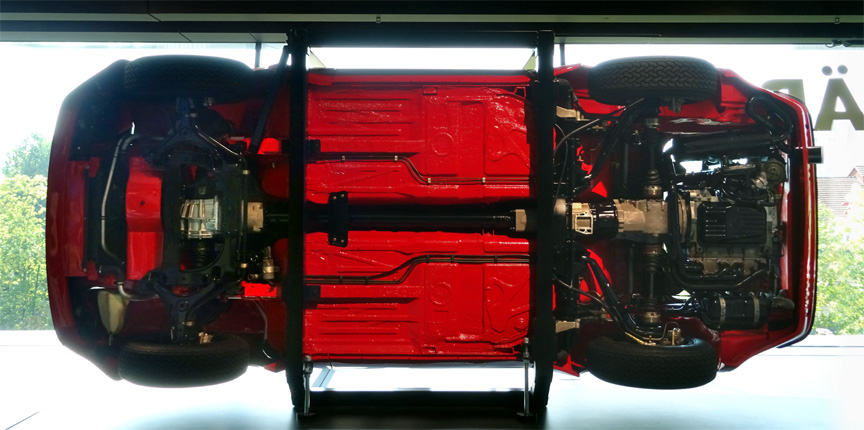
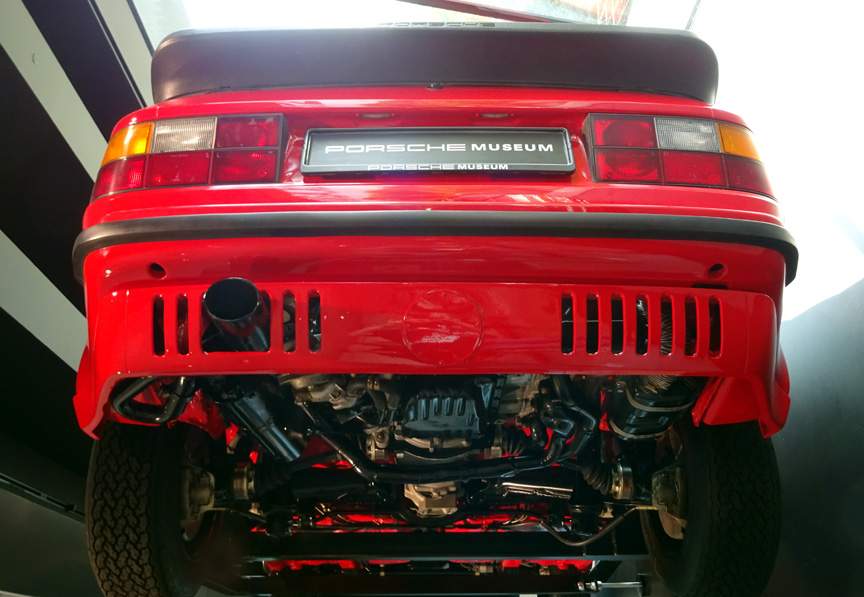
The 944 was introduced in USA a year later (in 1982 as a 1983 model) and as the US customers hadn’t seen the 924 Carrera versions sold in Europe, for Americans the 944 was even greater news from Porsche. The US and Japanese versions had to have the catalytic converters and in addition with internal modifications to the engine the power was reduced from 120 kW down to 110 kW.
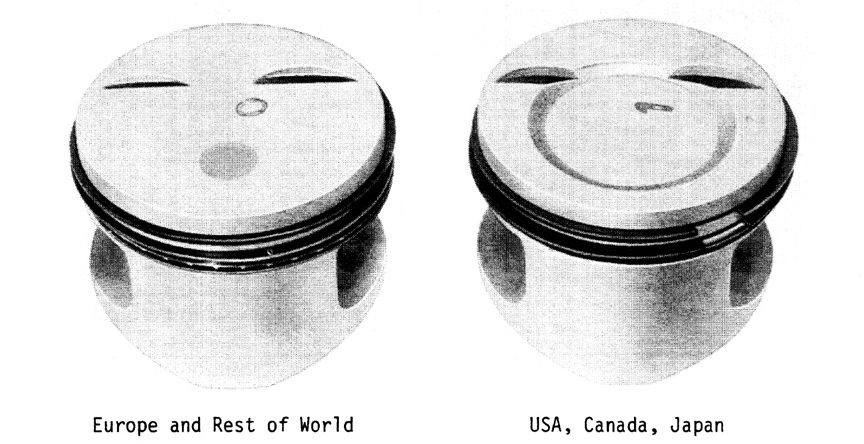
In addition to the loss of power, the US-version had to be fitted with heavy, almost military strength, front and rear bumpers. On the European models the bumpers were made of strong GFRP (glass-fibre reinforced plastic) and simply mounted to the structural members of the body. Consider that there were no speed limits in German highways and the GFRP bumpers were enough as designed by Porsche engineers (these bumpers needed to be replaced in the case of an accident). In order to sell cars in USA, the cars had to correspond to US DOT (Department of Transportation) regulations. Although from 1974, a 55 mph (88 km/h) speed limit was effective throughout the USA, the cars had to have bumpers strong enough to drive through a house. The bumpers for US versions were made longer, they were made of thick cast aluminium, they were equipped with heavy rubber bumperettes and they were mounted on shock absorbers before mounted to the body. That’s some serious weight to drag around every day with no other reason than a badly made federal law.



In the end of June of 1982, Longest Day of Nelson 24 hour race in Nelson Ledges, Ohio, USA, was won with the new 944 (in 1981, it was won with the 924). The event was held close to the longest day of the year, hence the name of the event. The reliability of the new 944 won the turbocharged and V8 muscles of USA. The 944 was driven by Freddy Baker, Bob Nikel, Gary Witzenburg and Tony Assenza.
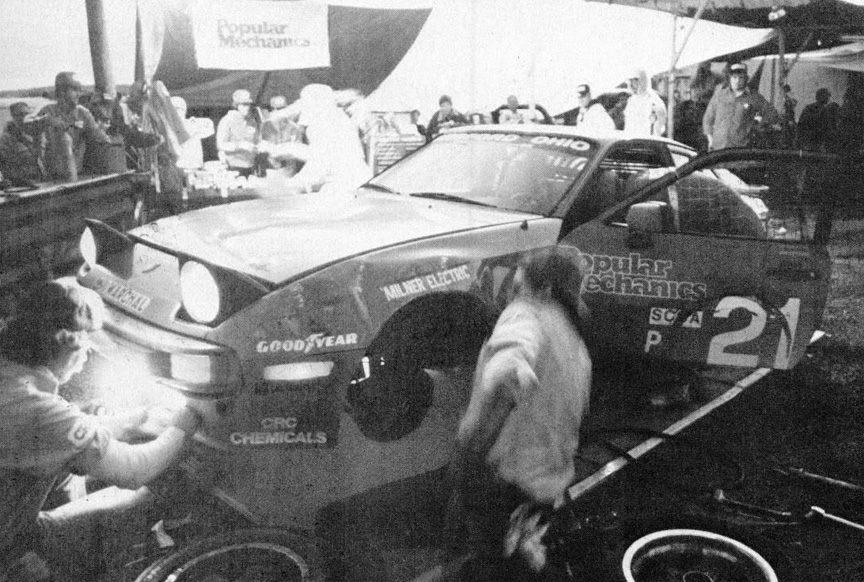
As a governmental initiative for car makers, Porsche also studied to run engines on methanol. While many 1979 924 test cars were modified to run on M15 methanol (15% methanol, 85% petrol mix), pure methanol (M100) was used for special 944 test engines in 1982. The basis was the 110 kW US version, but with methanol the modified engine put out 120 kW (the same as the non-cat European 944).
In 1983 in Europe there wasn’t really any public information available on the forthcoming Turbo-version of the 944, but in USA, on June 25, 1983, a prototype of the 944 Turbo was entered at the Longest Day of Nelson 24 hour showroom stock car race.
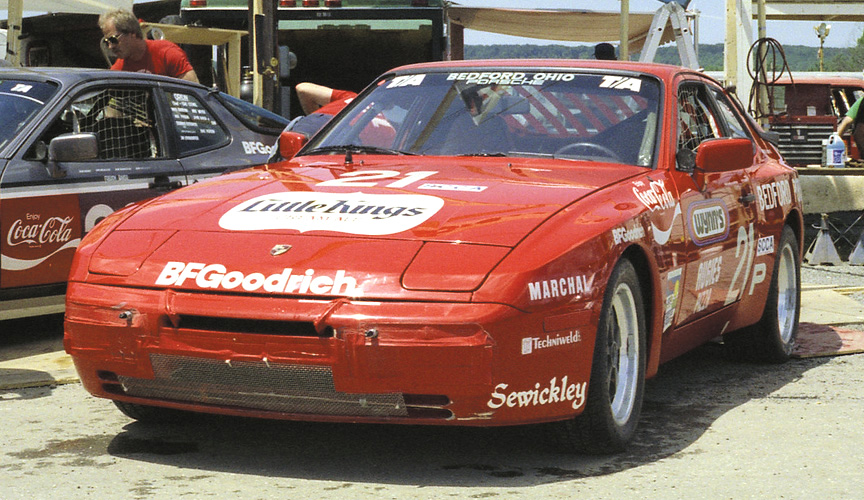
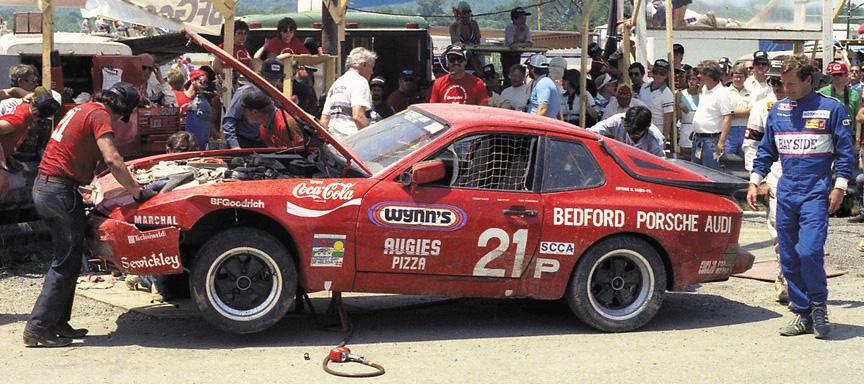
Engine wise this very early prototype was similar to the later production cars. The brakes were from regular 944 as the initial plan was to use 944 brakes also on the production Turbos. Visually it already had the 944 Turbo front spoiler and front fenders (slightly different from normal 944, to fit with the new front spoiler). This prototype didn’t yet have the slim side louvres nor the trademark rear under spoiler of the later production 944 Turbos. Inside, the prototype still had the old 924-derived 944 dashboard and seats.
Thanks to almost 50/50 weight distributon, in 1984, Car and Driver magazine named the 944 the Best Handling Production Car.
In 1983, for 1984 model year, 944 got the so-called Phone Dial design wheels. They were in the size of 15″ and with 951 spare part code meaning they were designed for the 944 Turbo (at that development phase it was planned to keep the “small” brakes from regular 944 also for the future 944 Turbo).

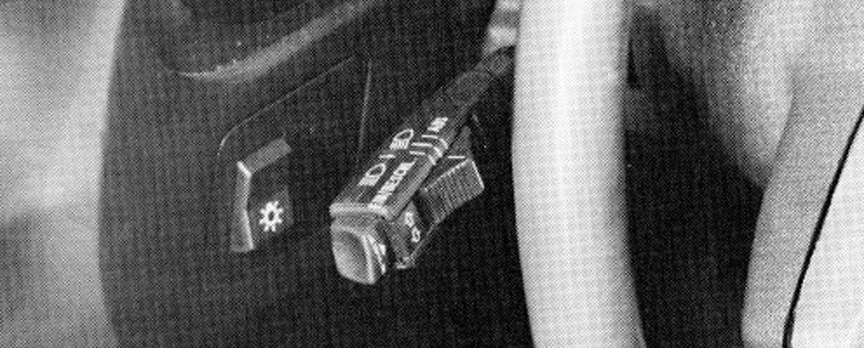
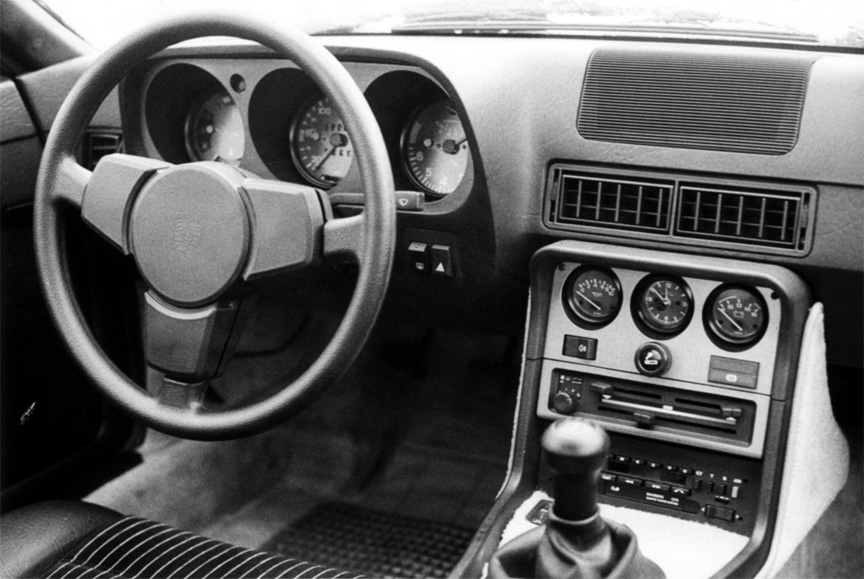
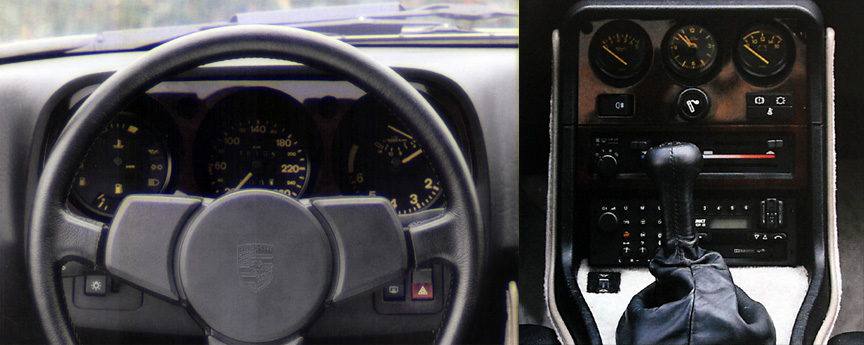
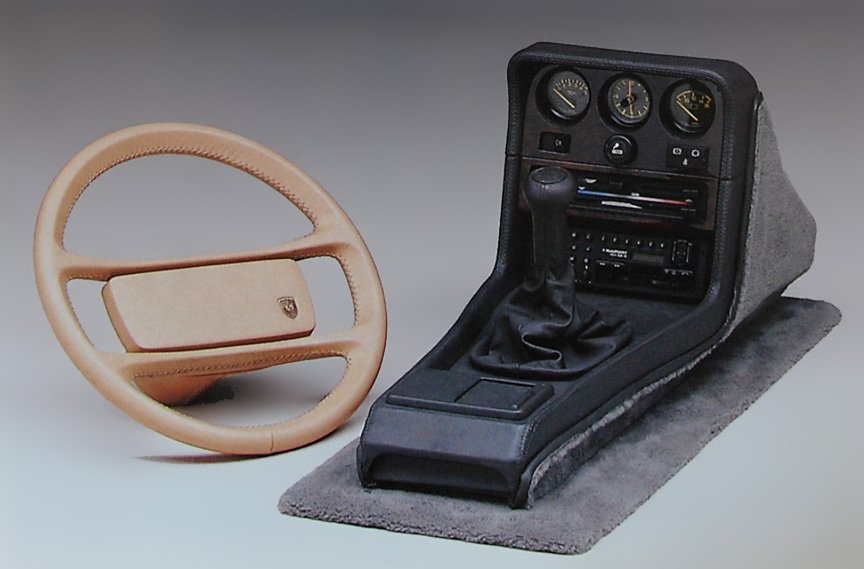
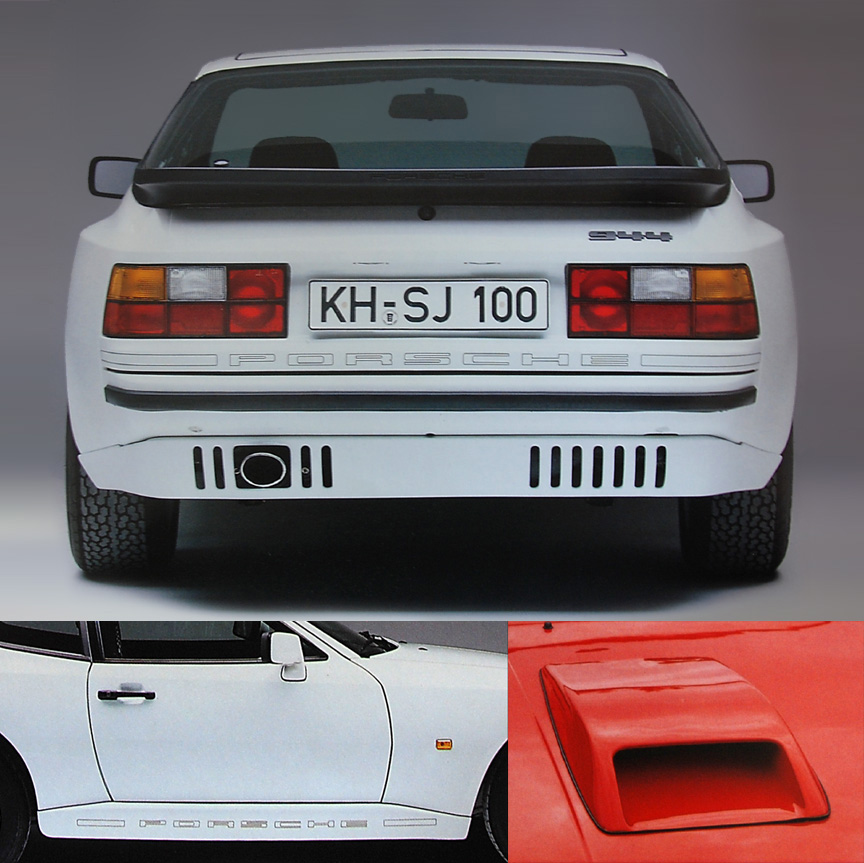
In 1983, for 1984 model year, 944 got the so-called Phone Dial design wheels. They were in the size of 15″ and with 951 spare part code meaning they were designed for the 944 Turbo (at that development phase it was planned to keep the “small” brakes from regular 944 also for the future 944 Turbo).
In spring of 1984 Rothmans cosmetic edition 944 was made, a batch of 100 numbered cars ordered by the French importer Sonauto (the subsidiary of Porsche AG) to celebrate the victorious Rothmans-sponsored Porsche 956 that had won Le Mans 24 hour race in France in 1982 and in 1983. At the time when the Rothmans 944 was sold, Rothmans-Porsche factory team decided to boycott the 1984 Le Mans race.
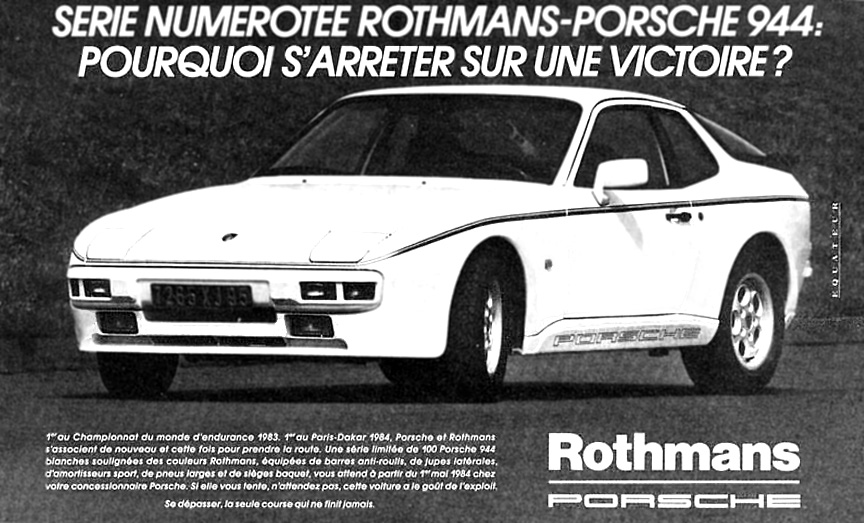
There was a German Metalworkers Union (IG Metall) 45-day strike from mid-May until the end of June 1984 that postponed the production of a few thousand ordered Porsches.
It was on June 30, 1984, that a 944 Turbo prototype was entered for the second time at the Longest Day of Nelson 24 hour race. The car had new rear under spoiler and new dashboard – it was more or less ready for production. The car was in almost stock condition, just that a Matter roll cage was installed. Although the car already had the 944.2 seats, the new sports seat was probably not available yet and the driver’s seat was exchanged to a 944.1 sports seat. Under the bonnet it was also quite stock with the exception of the aluminium induction pipes not being anodized black as on the series production cars. The VIN code of this 944 Turbo was WP0ZZZ95ZFN1500001, so by the VIN it was a 1985 model and first of them. At the 24 hour test the car was driven by Jim Busby, Freddy Baker and Rick Knoop. They won the race with huge margin in front of a regular 944.
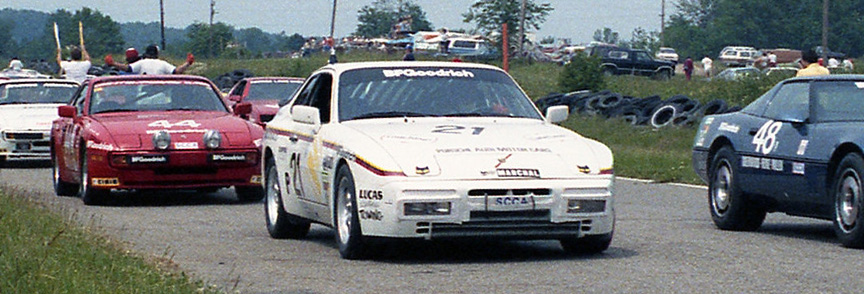
The 944 Turbo was finally announced at the Geneva Motor Show (Salon de l’auto Genève) on March 7, 1985. A full drivetrain and chassis was on the display to show that it was not just the engine that made the 944 Turbo, but also Brembo brakes with 4-piston aluminium calipers, a stronger gearbox and many other parts. The Turbo produced identical power output with or without the catalytic converter. At least that’s how it was announced in Geneva.
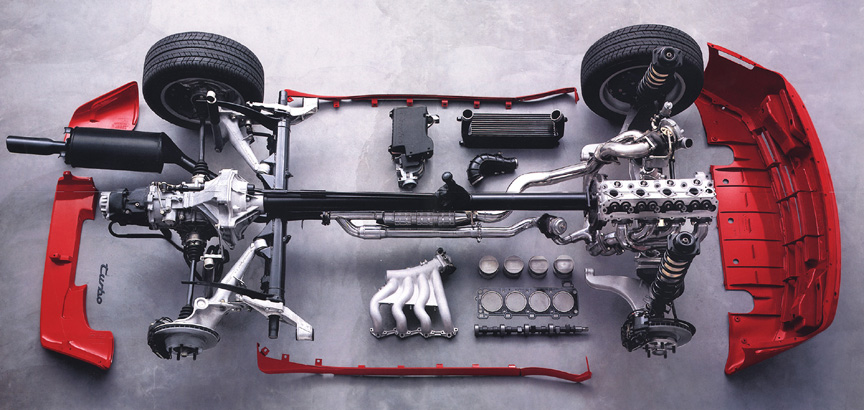
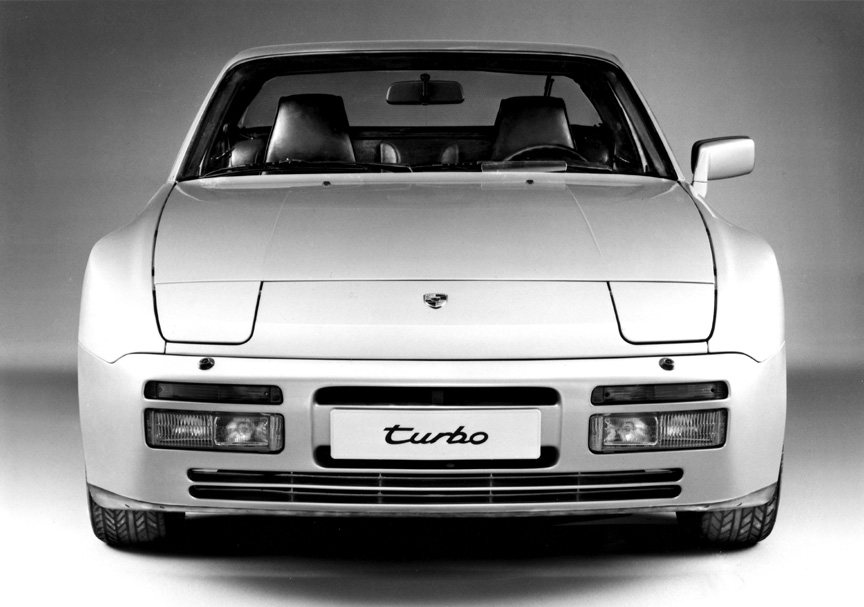

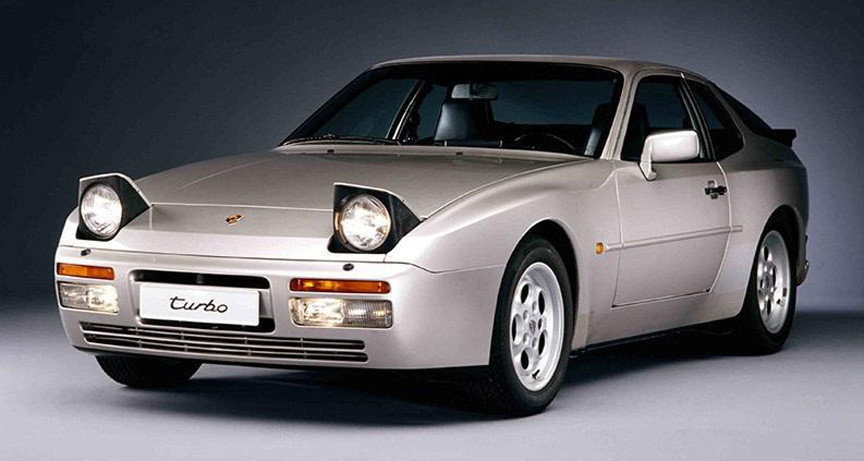
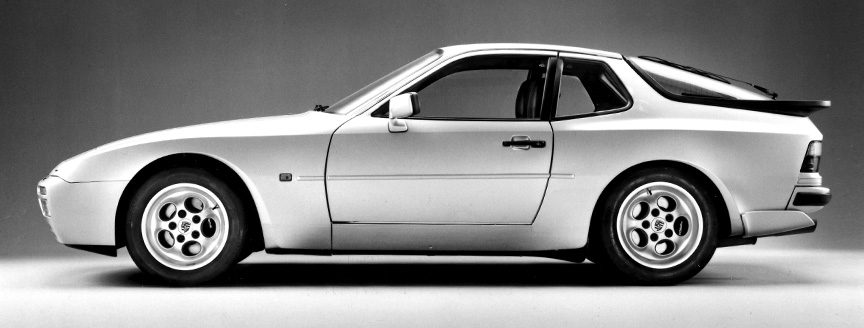
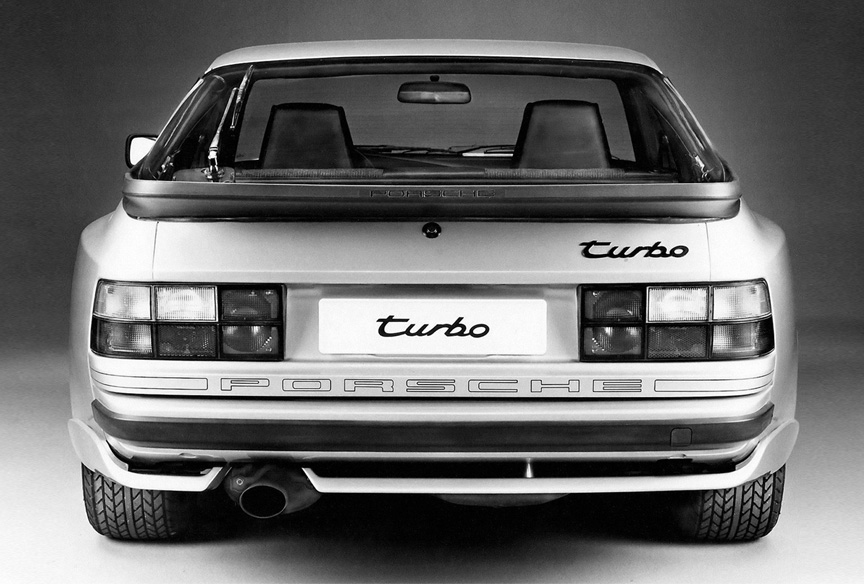
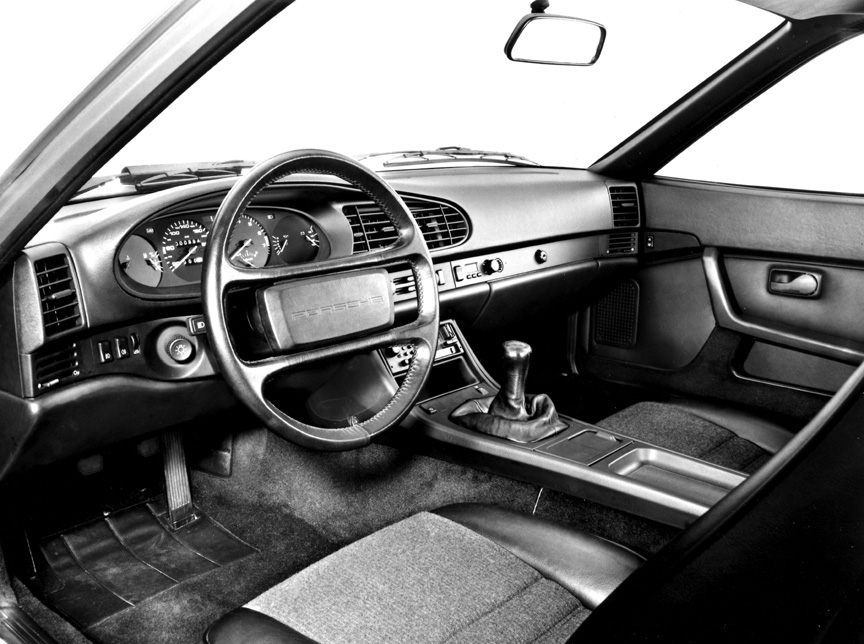
Car and Driver magazine commented on the 944 Turbo in April 1985 as follows
“Holy tire smoke! This little mutha hauls zass!”
At similar price compared to the 911 Carrera 3.2, the 944 Turbo was in many ways a better car – it had superb protection against corrosion, it was quick on the race track, its handling at high speed maneuvering was as predictable as it can get in a car, its cockpit was ergonomic (you could rest both of your elbows while driving), it had more headroom for the kids at the back and the enormous boot could even hold a baby trolley (entry level Porsches are for young people, right).
The 1985 model year brought so many changes to 944 in the middle of the model year. The new interior seen in the 944 Turbo became immediately 944’s standard interior from around May 1985 (the car is called as 944.2 or 944 85.5). The new dashboard required a new bodyshell. Power steering that greatly distanced the 944 from 924, used to be optional for 944.1, but was made standard for the 944.2. While the 944.1 speedometer was connected to the front wheel hub (like in the early Volkswagens and in 924), the 944.2 had a more sophisticated solution – the speed sensor was mounted into the gearbox. The front and rear control arms were now made of aluminium. Earlier 924-type metal fuel tank was replaced by a larger plastic unit. The catalytic converter became optionally available in Europe (was always standard in USA and Japan). While the interior was made nicer, there was a minor setback externally – the rain gutters were replaced by smooth trim strips, so when it rained and you opened the window, the water poured into to the car.
Less than 200 Turbos were made with 1985 model year VIN, making them really rare.
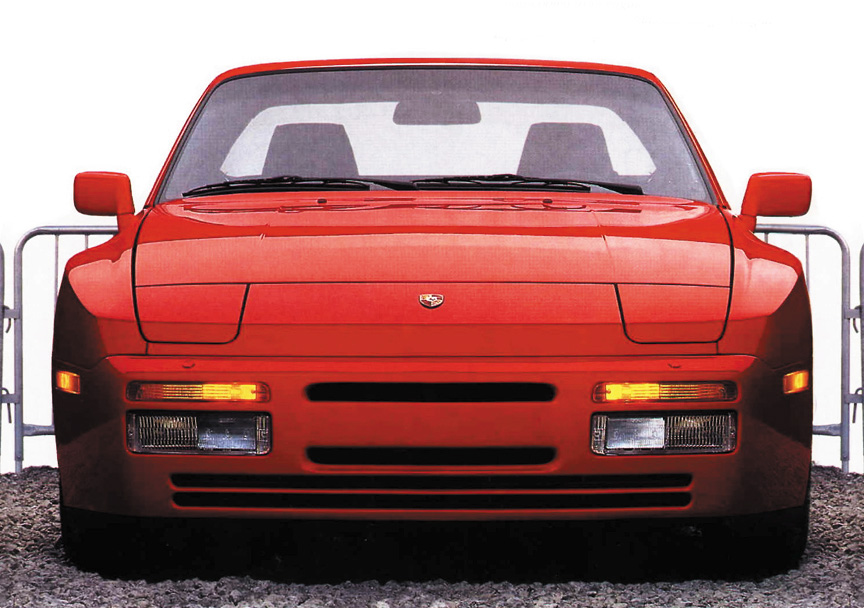
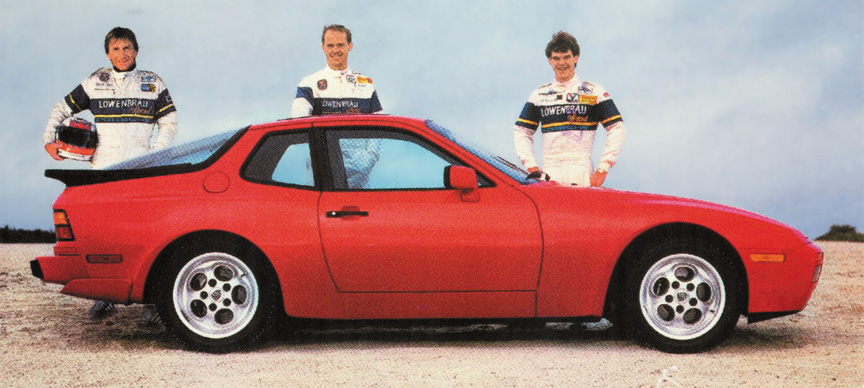
At the 1985 IAA Frankfurt Motor Show in September, a 944 Cabriolet study was shown. The cabriolet body was made by Baur. The car on the show already had wider axles and ABS (the first 944 Cabrio prototype had narrow axles like the production cars at the time). The Frankfurt show Cabriolet had the front design of the 944 Turbo, but it had normally asiprated 16 valve prototype engine of the later 944 S.
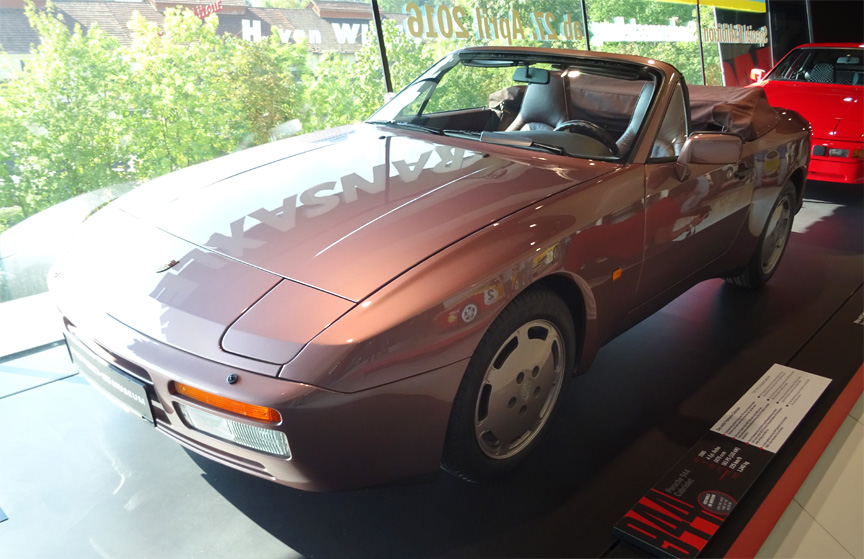
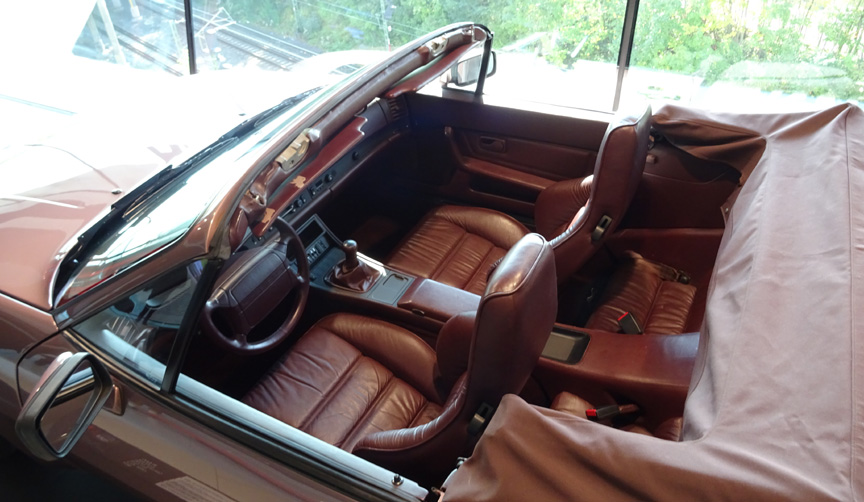
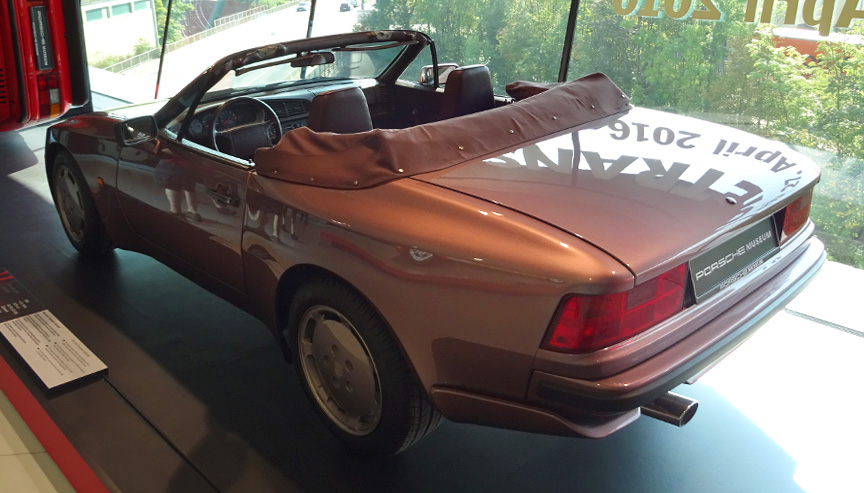
On January 29, 1986, a 944 Turbo with catalytic converter started to around the world record attempt from Porsche Cars North America Headquarters in Reno, Nevada, USA. The car was European version, with German number plates BB-PW167 (BB number plates on a Porsche tell it’s very likely a test car). The car was driven by Austrian professional long distance test driver Gerhard Plattner. This stock 944 Turbo covered 5 continents without any technical problems; the car was driven through the coldness of Canada (-18° F/-28° C) and the heat of Australia (+41° C/+106° F). The car arrived to its starting point in Reno after 31 days and 25.570 miles/41.140 km, averaging 825 miles/1327 km a day despite the off-days when the car was on the cargo planes. This was the fastest trip around the world in automotive history – and with a car with catalytic converter using unleaded fuel.
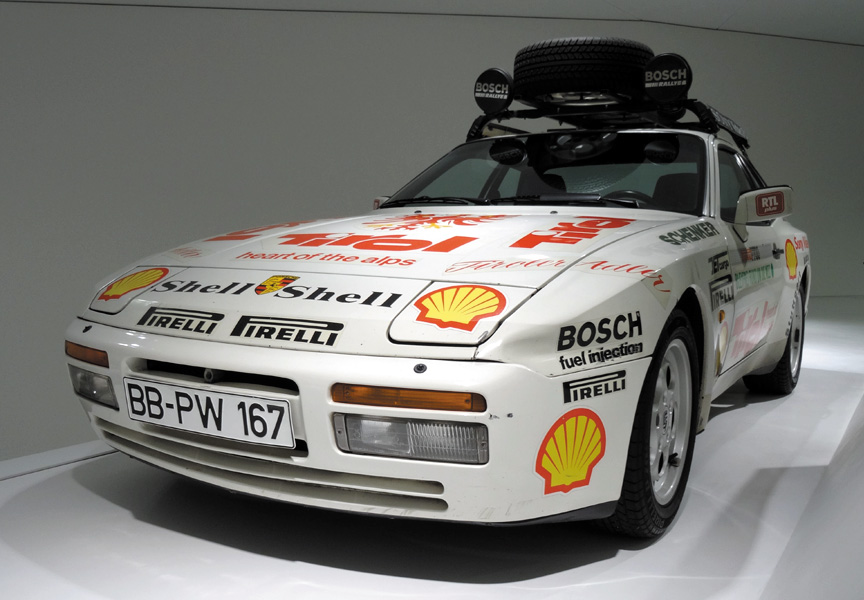
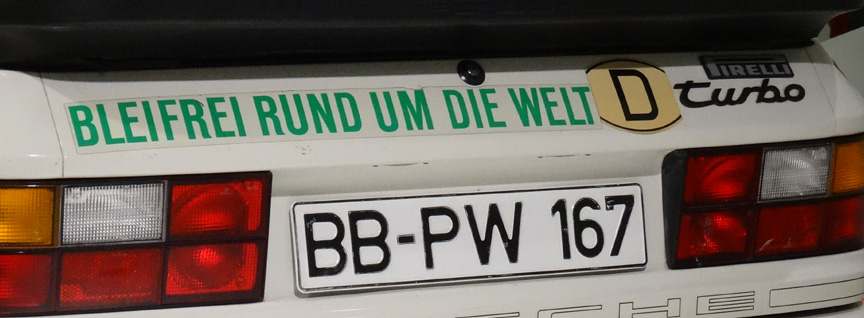
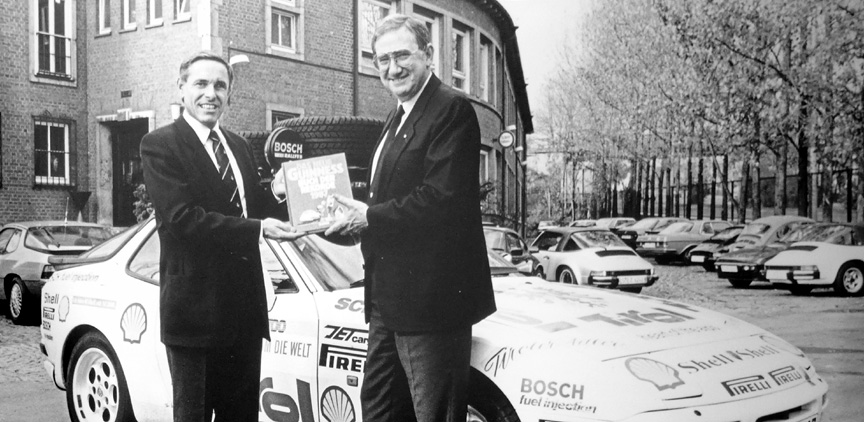
The 944 Turbo was used for other endurance tests aswell including 50.000 miles/80.000 km on German Autobahns in 4 months and 16 hours with average speed of 150 mph/240 km/h on Nardo test track (remember, car’s official top speed was 152 mph/245 km/h).
For 1986, Porsche 944 Turbo Cup series was created in Germany and 944 Challenge in Canada. These were the first Porsche one model racing series (predecessors of the later 911 racing series). The 944 Turbo Cup in Germany was held during the ADAC Würth Supercup (Group C) weekends at Nürburgring (twice), AVUS, Hockenheimring, Norisring and in addition a race at Mainz Finthen airport. The first 944 Turbo Cup race was held on April 27, 1986, on the Nürburgring GP track (which was built just two years earlier). It was a really special event to have more than 30 similar cars to fight so close to each other. Learn all about the 944 Turbo Cup here.
The peak 944 sales in Europe had been seen during the production of the 1985 model year, but thanks to US market, model year 1986 (production 8/1985-7/1986) became the most successful in the lifespan of the 944 – almost 28.000 cars were produced in a year including more than 10.000 944 Turbos.
Al Holbert, CEO of Porsche Motorsport North America in Warrington, Pennsylvania had contracted Fabcar Engineering in Tucker, Georgia in 1985, to build a tube frame race car mimicking the looks of the 944 Turbo. Fabcar was chosen because they built Porsche 962 monocoques. The car was ready in 1986 and the official specs read 2.5-litre 8V turbo 525 hp @1.6 bar (1987 specs: 575 hp @ 1.5 bar), empty weight 906 kg/1980 lb. The engine was prepared by Andial and the brakes were from Porsche 962. The low and wide car was called 944 GTR.
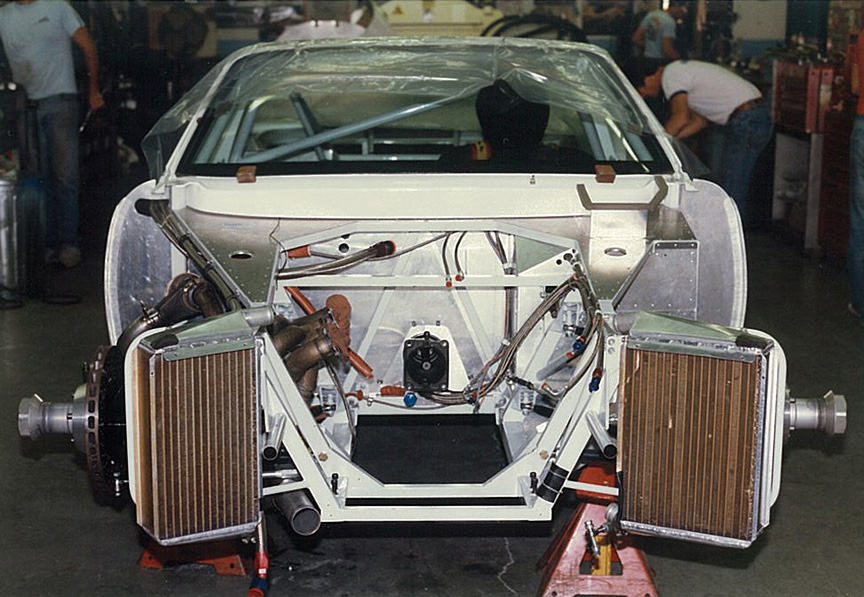
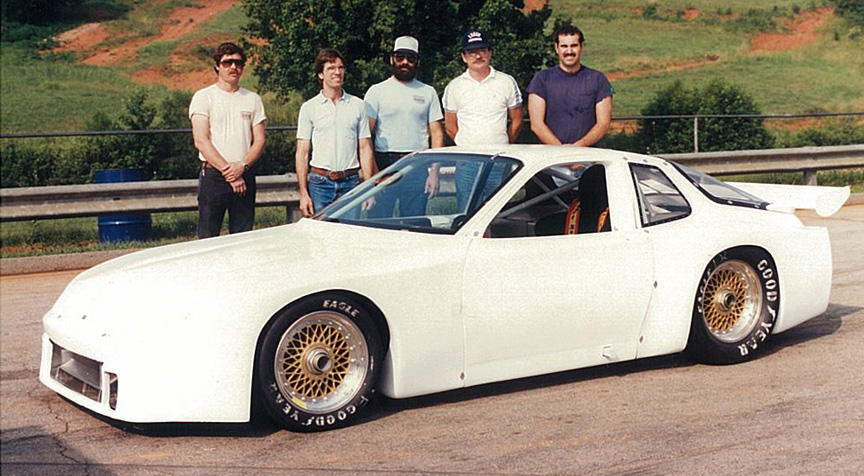
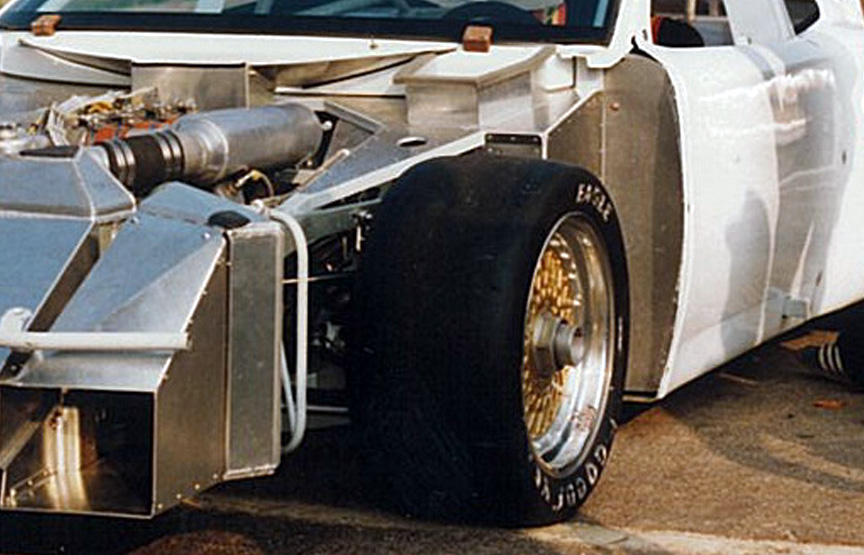
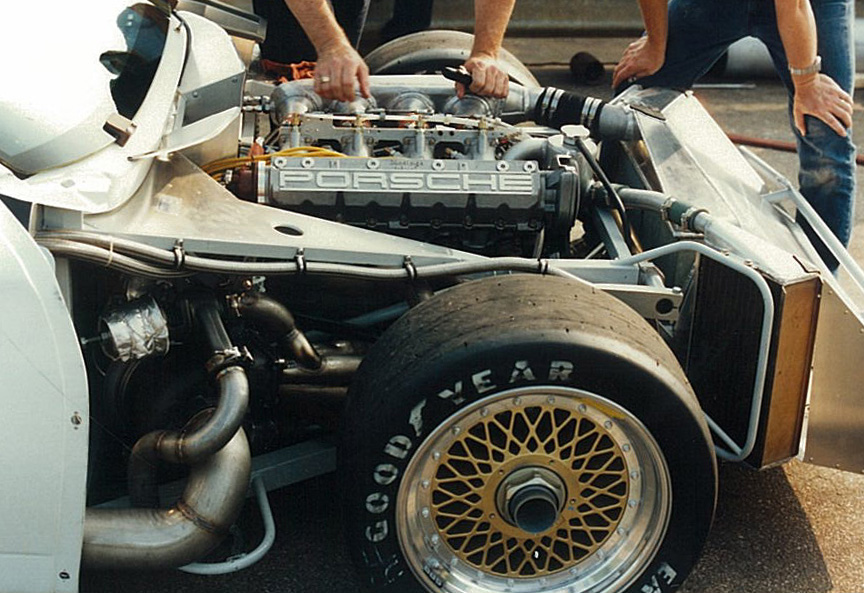
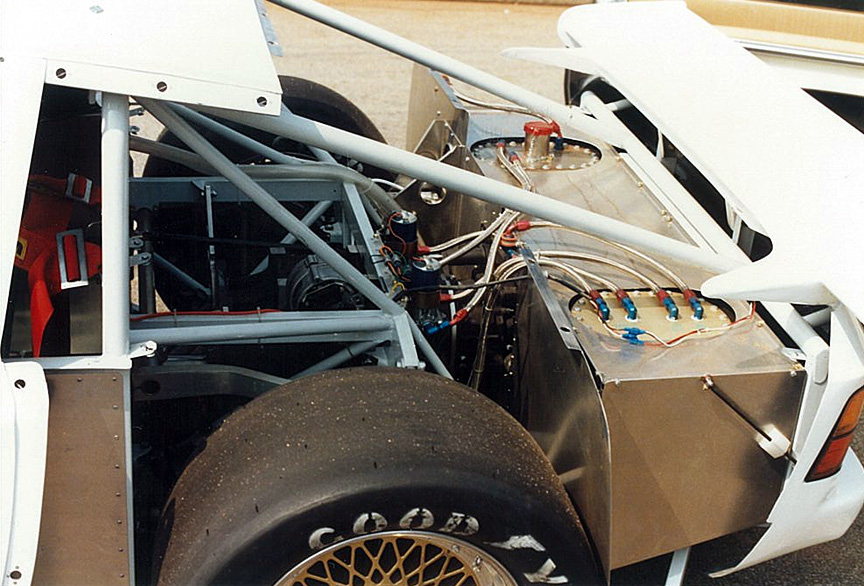
The Fabcar 944 GTR prototype didn’t look close enough to 944 Turbo, so new front and rear spoilers were created.
Although it was planned to start the 1986 SCCA Trans Am season from the beginning, finally in September the 944 GTR had its first race. Unfortunately none of the four races the 944 GTR competed in 1986, couldn’t be finished due to mechanical problems or accident.
In 1986, Porsche started to install airbags into the 1987 model year 944 Turbos. They were optional for European versions, but standard for US versions, a world first!
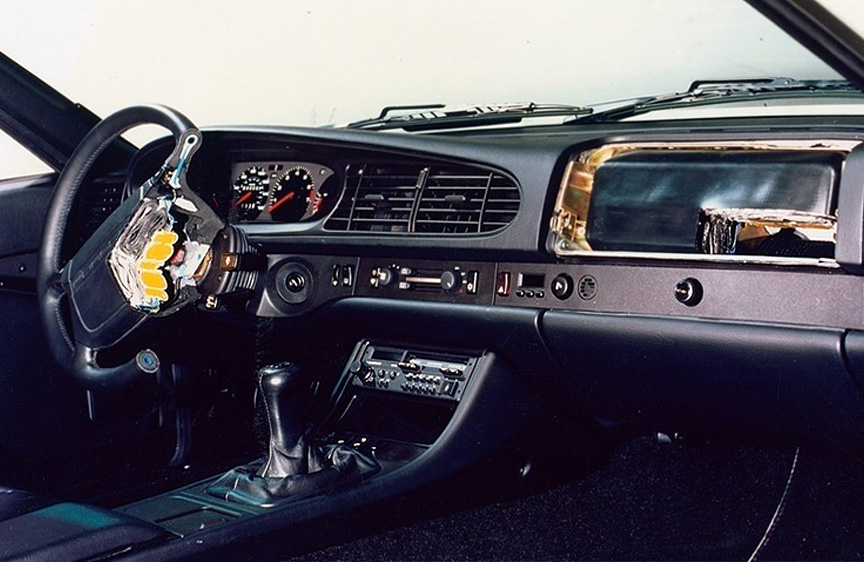
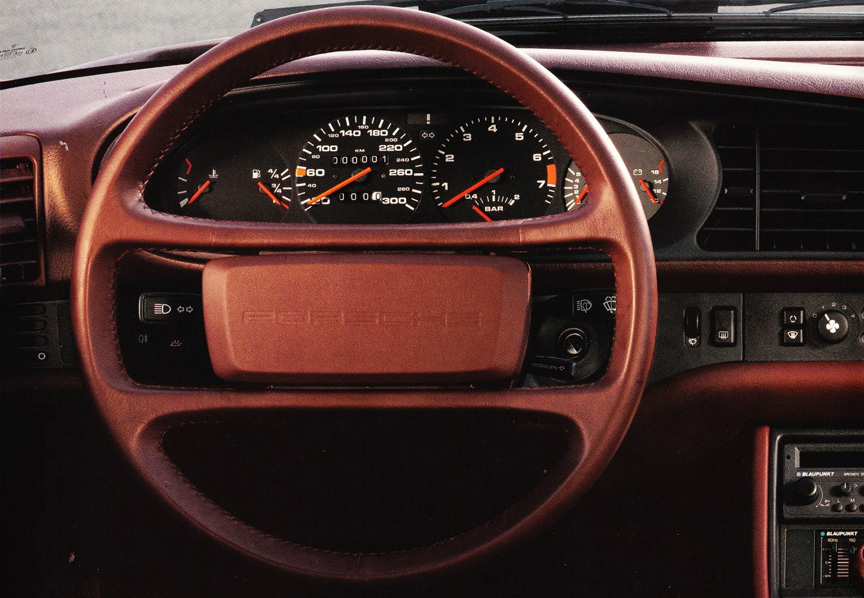
In 1986, for 1987 model year cars received new wider axles. New front axle improved the handling. Axles with new width meant the cars needed new wheels with new offset (ET). Until 1986 model year wheels with very wide outer rim could be used, but not anymore (now the inside part was wider). So, the car’s visual appeal decreased in favour of better handling starting with the 1987 model year. This model year brought the ABS brakes, a serious improvement in safety and also in lap times. At the same time, for the 911 Carrera or 911 Turbo, ABS would not be available for a few years even for hard currency.
It was planned to launch the 944 Turbo also with a double-clutch PDK (Porsche DoppelKupplung) gearbox, but despite long development it wasn’t reliable enough to put it into series production. It was as early as 1964, when Porsche had worked on a power shift dual clutch gearbox. Starting in 1979, various versions of dual-clutch gearboxes were designed. On this basis, the PDK was created in 1981. It was tested until 1986 in Porsche street cars in parallel to the Group C Porsche racing car, as a semi and fully automatic version. Gear shifting without interruption in propulsive power proved particularly interesting for the turbocharged engines, as the turbo boost would not drop during the gear change.
The 16-valve 944 S was introduced as a 1987 model. Visually it looked like the normal 944 except it had 16″ wheels as standard. On the paper the 944 S had 140 kW and more torque despite the unchanged engine capacity, but in the real life these engines seemed to have less low-end torque (the 944 S shows its added power on the race track, but no increase in everyday usability).
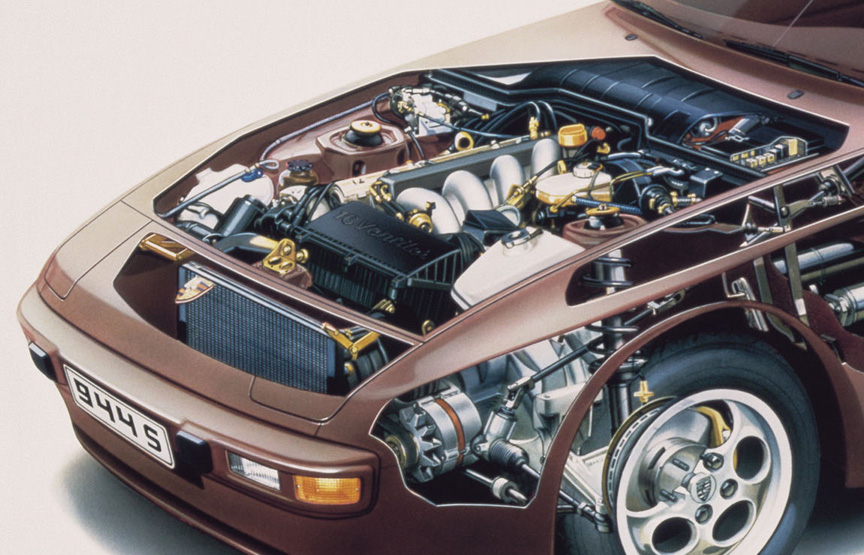
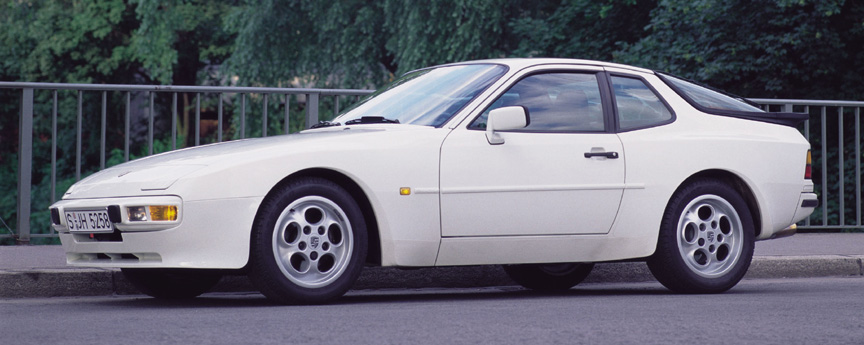

On January 15, 1987, Gerhard Plattner started another Porsche long distance test. The aim was to cover the distance equal to from Earth to Moon – 384.405 km (238.909 miles) – in one year. The car was a US-version 944 S and the ‘Operation Luna 944’ was started in USA, at Cape Canaveral.
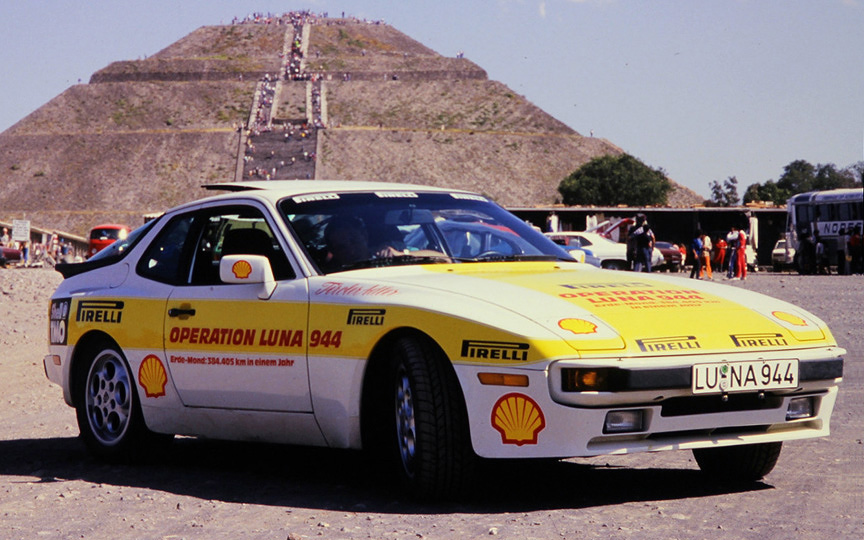
Sales in Europe had dropped dramatically for model years 1986 and 1987 and 71% of the 1987 model year 944s went to America. During the 1987 model year, the base model with catalytic converter had got power increase from 110 to 118 kW and the non-cat 120 kW version was dropped.
In the end of summer 1987, “944 Special Edition 1988″ (M757) cars were made to celebrate 250.000th 911 produced!? The 944 sales must have really dropped to present an edition with such a cause… Some say it was built to honour the 100.000th 944 made, but this milestone was passed already in the end of 1986. The Special Edition cars were Zermatt Silver or Satin Black Metallic. The cars were equipped with commemorative plaque (2.5″/65 mm diameter) which could be personalized with the owner’s name. The cars had plaid cloth seats and door panels, new separately folding rear seat backrests, automatic heating control, 16” wheels and a few other options as standard.

In the meantime, the ‘Operation Luna 944’ was still going on. After 258 days the mission was accomplished thanks to master Gerhard Plattner and many journalists who helped to keep the car rolling all the time. 384405 km in 258 days means averagely 926 miles/1490 km a day including the time for many photoshootings, of servicing the car every 2 weeks (~12.000 miles/~20.000 km interval), at gas stations, on the cargo plane etc.
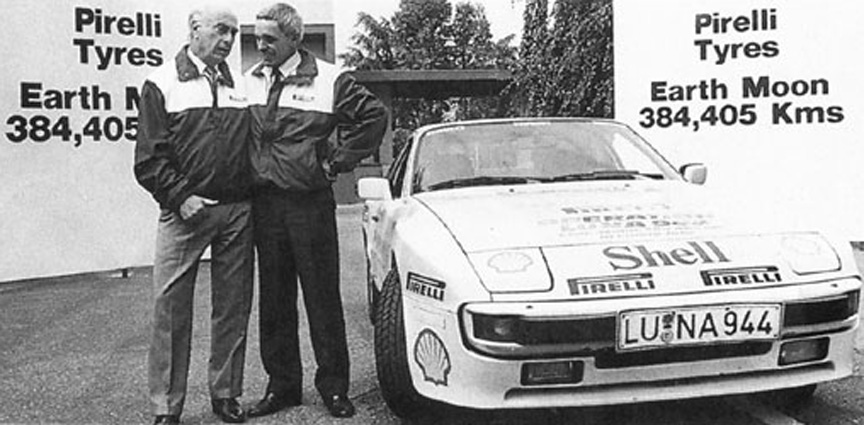
Luckily, the endurance test could be made without any major accidents and it was decided to carry on the test until 500.000 km (310.752 miles), which was reached on December 17, 1987.
In the end of 1987, 184 kW 944 Turbo S was introduced. The engine code of the Turbo S was M44.52. Top speed rose to 162 mph/260 km/h. Official 1/4-mile time was 13.5 seconds, which was very fast for a street legal car and naturally the fastest 4-cylinder car in the world. The car with bigger turbocharger was better on the race track, but not in the city because of added turbo lag (the 162 kW version started to pump at around 3500 rpm while the 184 kW needed 4000 rpm). In addition to the power boost, the Turbo S came as standard with the M030 sports chassis, larger front brakes, LSD and other features/modifications.
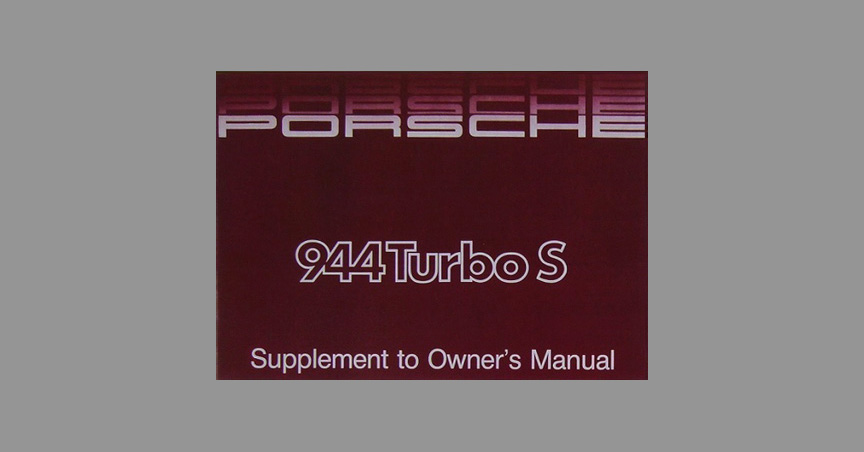
In the end of 1988 (model year 1989) the ‘S’ designation was dropped from the Turbo S, and all 944 Turbos now featured the 184 kW engine and larger front brakes.
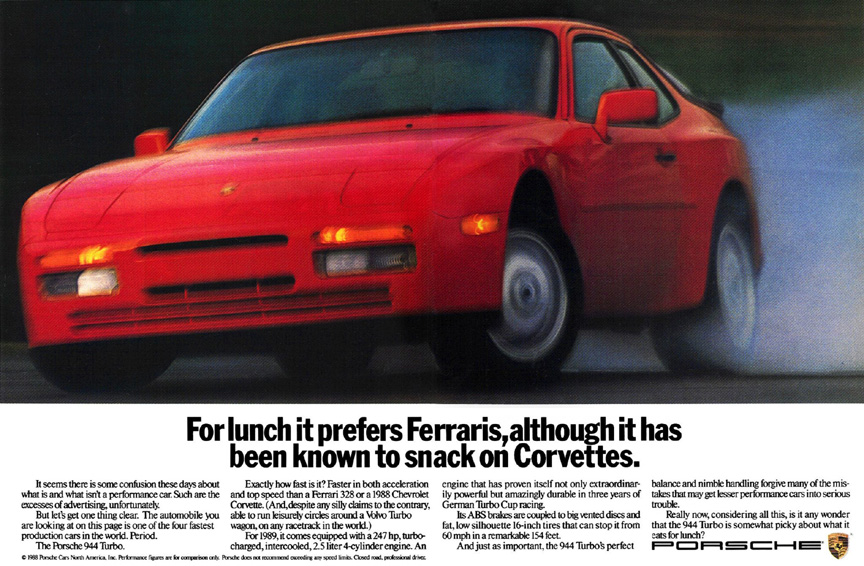
For 1989 model year a new 944 engine block with larger bore was made which meant the 2.5-litre engine grew to 2.7-litre for the last model year of the base 944. The power increase was minimal, but thanks to larger engine capacity the torque rose. While more power makes the car faster on the race track, more torque makes it more comfortable to drive in the city. With a new crankshaft the stroke of the 2.7-litre engine was increased 12% which resulted in a 3.0-litre engine. This 3-litre was equipped with 16-valve cylinder head and the car was called 944 S2.
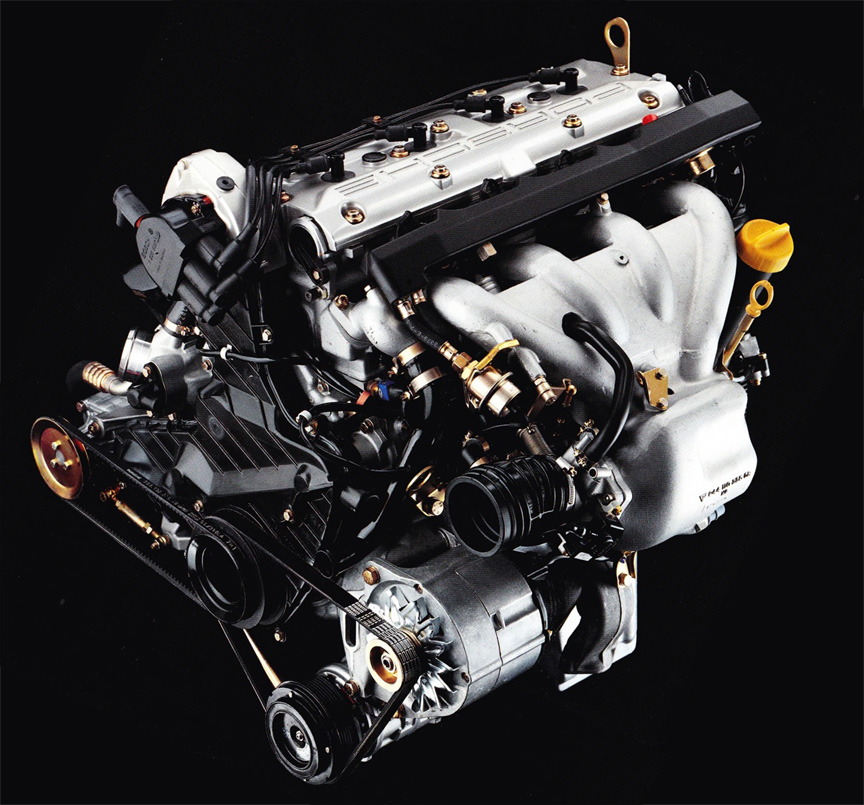
The 944 S2 looked exactly like the Turbo and it also had the aluminium caliper brakes of the previous model year 162 kW Turbo. Model year 1989 cars with alarm system now had interior door lock knobs with diodes signalling if the alarm system was on. The alarm system used to have separate key hole on the rear fender, but not anymore from MY1989. New options were seat heating and CD-player (labeled as “Porsche”, but produced by Alpine). The 184 kW Turbo was 20% more expensive than the discontinued 162 kW Turbo which meant now the 944 Turbo was more expensive than the 911 Carrera. While air conditioning was a standard feature on all US-market 944 Turbos from the beginning, it became standard also in Europe from 1989 model year.
The 944 Cabriolet was finally launched. In 1989, the Neckarsulm Audi factory celebrated the 300.000th Porsche produced (924, 924 Turbo, 924 Carrera GT, 924 S, 944, 944 Turbo, 944 S, 944 S2, 944 S2 Cabrio). In 1989, starting with the 1990 model year, 944 Turbo received a new bridge-type rear spoiler. It was stronger than the rubber unit and gave better downforce at top speed. 944 S2 got it a year later, for the last production year.
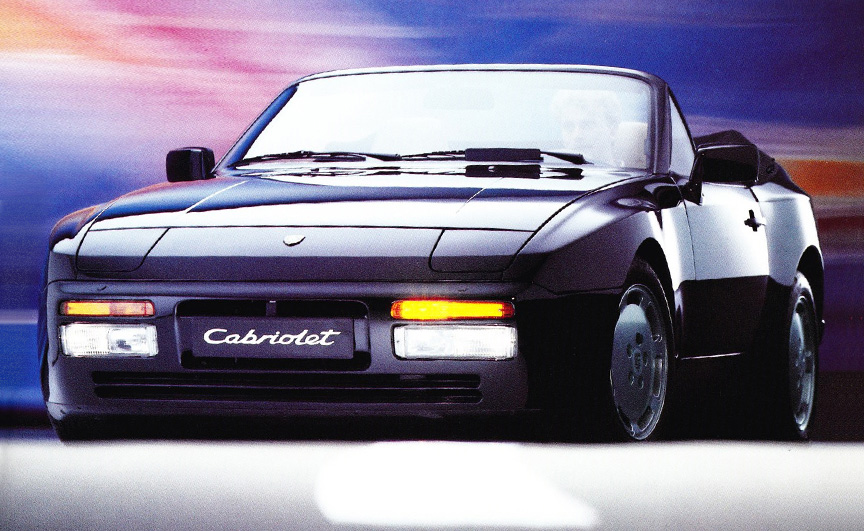
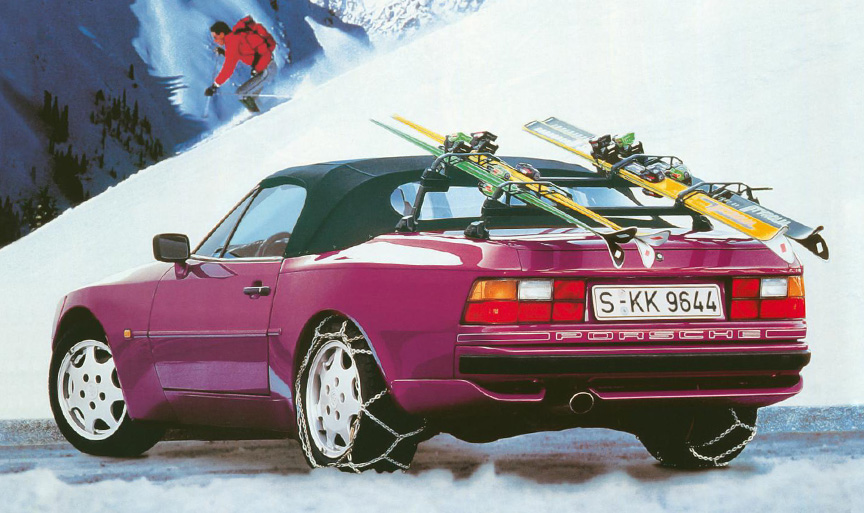
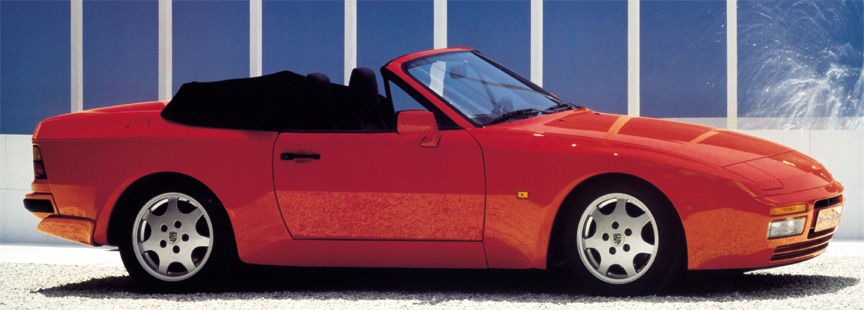
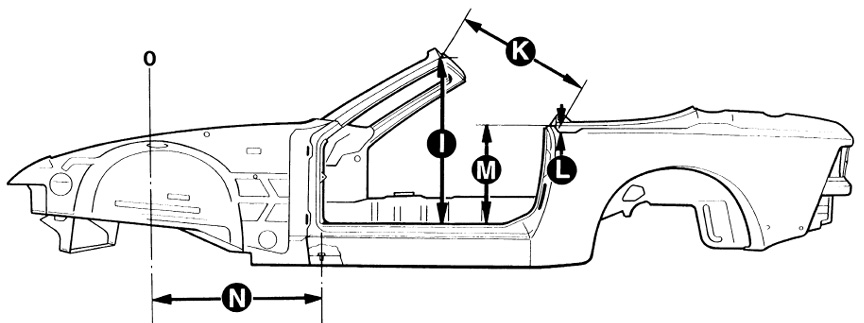
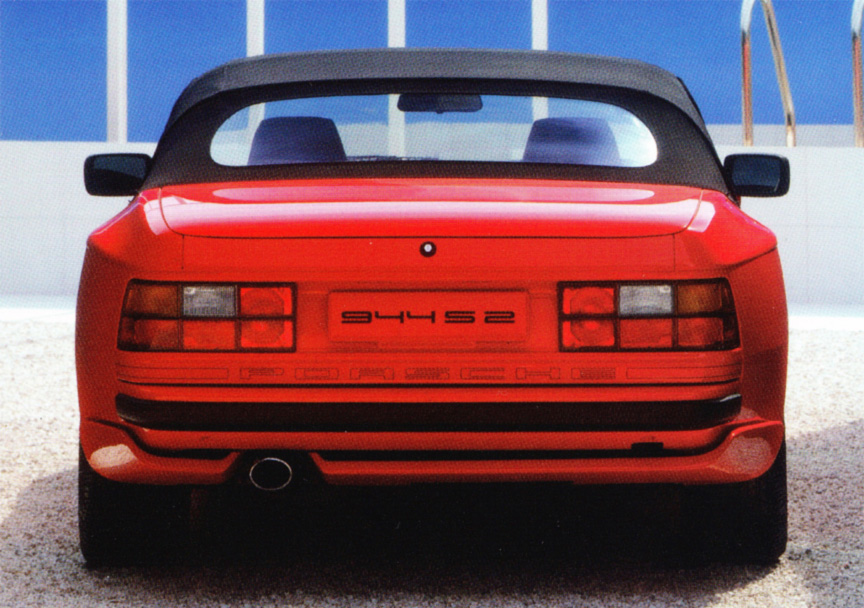


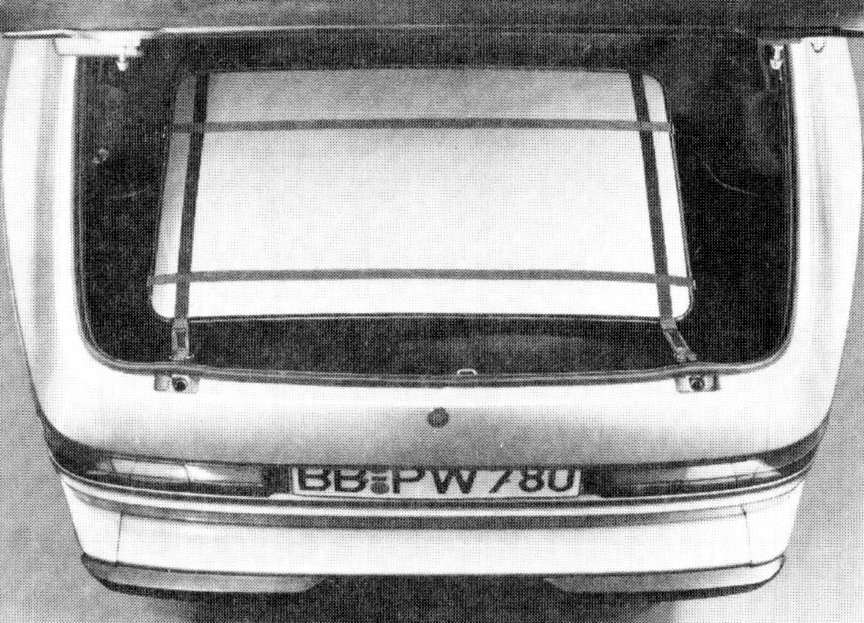
10th production year was the last for the 944 and it was celebrated worthily, with the launch of the 944 Turbo Cabriolet. Only around 600 were made, none for America, though.
Like the 924, most of the 944 were produced by Audi at its Neckarsulm plant. Only the last 944 S2 coupés and cabrios were made in Stuttgart where the production of the successor, the 968, was set up. To understand if your 1991 944 S2 was made in Neckarsulm or in Stuttgart, look for the 11th character in the VIN – is it “N” or “S”?
The total production number of the 944 was more than 160,000 including more than 25,000 Turbos. USA was the no.1 market, acquiring 52% of all 944s produced. It was not planned to end the 944 series after its 10th year yet, but it was planned to change the headlamp design in order to make the entry level model look like a family member with the 911 and 928. The other reason was the pedestrian safety issue (in an impact with a person the open headlamp could cut like a knife). So, the new 944 S3 was designed with new front and rear end, but at the last moment renamed to Porsche 968. If you know which component to look at on a 968, you can find ‘944 S 3’ designation.
944, especially the Turbo, but also S2, remain one of the greatest Porsches thanks to their 50/50 weight distribution, ergonomic cabin, large boot, and of course, flared fender design.


